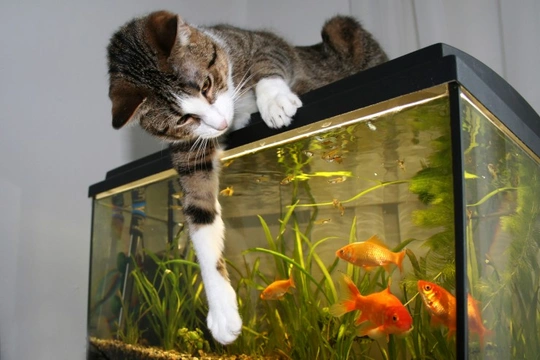
Keeping Your Fish Tank Safe From Your Cat: A UK Guide
Fish tanks can be a huge source of entertainment and stimulation for your cat – almost like watching TV for humans. However, an inquisitive cat can cause stress to your fish, even catch them or damage the tank if it tries to jump or climb on it.
Keeping your aquatic pets safe while allowing your feline friend to enjoy the sight of a fish tank involves thoughtful planning and practical strategies. In this comprehensive guide, you'll learn how to site and secure your fish tank to protect both your fish and cat, promoting a peaceful coexistence.
Where Should You Situate the Fish Tank?
Choosing the right spot for your fish tank is the first step in cat-proofing it. You want to fulfil your fish's needs for appropriate lighting and water conditions, but also consider your cat's curiosity.
Ideally, place the tank somewhere visible for you to enjoy but out of your cat's easy reach. Avoid low-level surfaces, windowsills, or areas where your cat can leap onto furniture and then onto the tank. Elevating the tank on a high, sturdy stand keeps it out of immediate reach and reduces stress for your fish.
Choose a Stable and Secure Stand
Use a fish tank stand designed specifically for the tank’s size and shape. Stability is crucial because some cats are excellent jumpers and climbers and may try to paw or jump on the tank.
The stand and floor should be flat and even to prevent wobbling. Avoid tanks with narrow bases or shapes that resist tipping but can rock if pushed. A stable tank reduces the risk of accidents or injury to your fish or cat.
Installing a Robust Tank Lid
A solid, fully enclosed lid is essential when you have a cat. The lid must fit tightly on the tank and be durable enough to bear your cat’s weight without slipping or breaking.
Consider lids with clipped fastenings or locks to prevent your cat from pushing them off. Some owners add barriers atop or around the lid, such as smooth but slippery surfaces or objects that obstruct safe landing, to deter jumping.
Creating a Cat-Safe Viewing Distance
Keep your cat’s viewing distance at around two feet (60 cm) from the front of the tank. This proximity allows your cat to watch the fish without encouraging pawing at the glass or causing your fish stress.
If your cat shows excessive interest, try positioning furniture or other barriers to prevent it from getting too close while still letting it enjoy the display from a safe distance.
Use Sensory Deterrents to Discourage Climbing
Cats dislike certain textures and sounds. Applying double-sided sticky tape, sticky mats, or specially designed cat deterrent mats around the tank can discourage climbing or pawing.
Aluminium foil sheets placed on or near the tank can also deter cats because of their noise and texture. These deterrents need replacing occasionally but are humane and safe for both pets.
Provide Plenty of Aquarium Cover for the Fish
Leafy plants, rocks, and other covers inside the aquarium offer hiding spaces for your fish. This not only mimics their natural habitat but reduces stress caused by a cat watching or pawing at the glass.
Well-covered tanks help your fish feel secure, reducing the chance they'll hide excessively or become aggressive, contributing to a healthier aquatic environment.
Distract and Enrich Your Cat’s Environment
Providing your cat with ample alternative entertainment helps reduce its focus on the fish tank. Cat trees, puzzle feeders, interactive toys, and high perches satisfy natural hunting instincts and curiosity.
Regular playtime and environmental enrichment are vital for a content and less intrusive cat, ensuring the fish remain safe and stress-free.
Store Fish Food Securely
Fish food can attract your cat due to its scent, so store all fish food in airtight containers away from the tank area. Minimising food smells near the tank reduces your cat’s temptation to investigate or attempt to access the tank.
Common Mistakes to Avoid
- Ignoring the importance of a secure, sturdy lid – a flimsy lid risks accidents.
- Placing the tank where the cat can easily jump on or paw at it.
- Using only one deterrent method – combining physical and sensory deterrents is most effective.
- Neglecting to enrich your cat’s environment, which may increase its fixation on the tank.
- Leaving fish food exposed, attracting persistent cats.
Summary: Key Tips for a Cat-Proofed Fish Tank
- Position your fish tank high up, away from cat-accessible furniture.
- Use a strong, tightly fitted lid secured with clips or locks.
- Apply safe deterrents like sticky tape or aluminium foil on or around the tank.
- Maintain a safe viewing distance from your cat to the tank.
- Enrich your cat’s environment with toys and climbing structures.
- Store fish food securely to prevent attracting your cat.
- Provide plants and cover inside the aquarium for fish security.
- Supervise your cat near the tank until it learns boundaries.
With careful setup and attentive care, you can build a harmonious home where your curious cat and vibrant fish thrive safely together. This combination of sensible physical barriers, sensory deterrents, and environmental enrichment supports responsible pet ownership and happy pets.
Enjoy your striking aquarium display along with the endless entertainment it provides your inquisitive cat while keeping stress and risks to a minimum.
For further pet care and responsible ownership advice, always consult your local vet or animal behaviour specialist to adapt strategies to your unique household situation.
Explore fish for sale or find a kitten to balance your pet family harmoniously.



